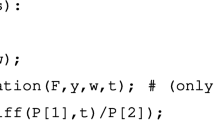Abstract
We study the diagonalization problem of certain discrete quantum integrable models by the method of Baxter's T–Q relation from the algebraic geometry aspect. Among those the Hofstadter type model (with the rational magnetic flux), discrete quantum pendulum and discrete sine-Gordon model are our main concern in this report. By the quantum inverse scattering method, the Baxter's T–Q relation is formulated on the associated spectral curve, a high genus Riemann surface in general, arisen from the study of spectrum problem of the system. In the case of degenerated spectral curve where the spectral variables lie on rational curves, we obtain the complete and explicit solution of the T–Q polynomial equation associated to the model, and the intimate relation between the Baxter's T–Q relation and algebraic Bethe Ansatz is clearly revealed. The algebraic geometry of a general spectral curve attached to the model and certain qualitative properties of solutions of the Baxter's T–Q relation are discussed incorporating the physical consideration.
Similar content being viewed by others
References
S.S. Lin and S.S. Roan: Algebraic geometry approach to the Bethe equation for Hofstadter type models, cond-mat/9912473.
S.S. Lin and S.S. Roan: Baxter's T–Q relation and Bethe Ansatz of discrete quantum pendulum and sine-Gordon model, hep-th/0105140.
A. Bobenko, N. Kutz, and U. Pinkall: Phys. Lett. A 177 (1993) 399.
L.D. Faddeev and R.M. Kashaev: Comm. Math. Phys. 155 (1995) 181.
J. Kellendonk, N. Kutz, and R. Seiler: in Oxford Lectures Series in Mathematics and Applications, No 16, 1999, p. 247.
R. Baxter: Ann. Phys. 70 (1972) 193; 76 (1973) 1; 25; 48.
L.D. Faddeev: in Proceedings of the Les Houches summer school, Session LXIV, Les Houches, France, August 1–September 8, 1995 (Eds. A. Connes, K. Gawedski, and J. Zinn-Justin), North-Holland, Amsterdam, 1998, p. 149. L.A. Takhtadzhan and L.D. Faddeev: Russ. Math. Surveys 34 (1979) 11.
P.P. Kulish and E.K. Sklyanin: in Lecture Notes in Physics, Vol. 151, Springer, 1982, p. 61.
A.G. Izergin and V.E. Korepin: Nucl. Phys. B 205 (1982) 401. V.O. Tarasov: Theor. Math. Phys. 63 (1995) 175.
M.Ya. Azbel: Sov. Phys. JETP 19 (1964) 634.
D.R. Hofstadter: Phys. Rev. B 14 (1976) 2239.
P.B. Wiegmann and A.V. Zabrodin: Nucl. Phys. B 422 (1994) 495; 451 (1995) 699.
Author information
Authors and Affiliations
Rights and permissions
About this article
Cite this article
Lin, SS., Roan, SS. Algebraic Geometry in Discrete Quantum Integrable Model and Baxter's T–Q Relation. Czechoslovak Journal of Physics 52, 737–748 (2002). https://doi.org/10.1023/A:1016233911940
Issue Date:
DOI: https://doi.org/10.1023/A:1016233911940



